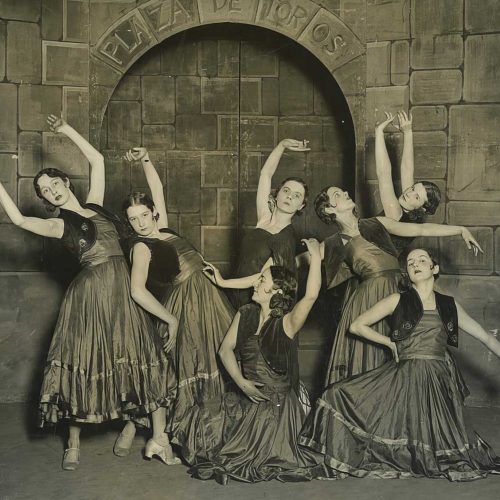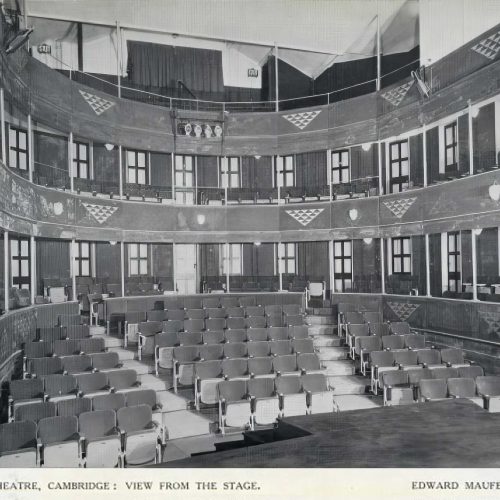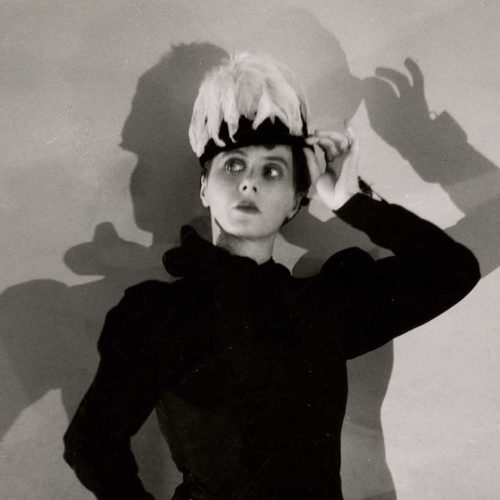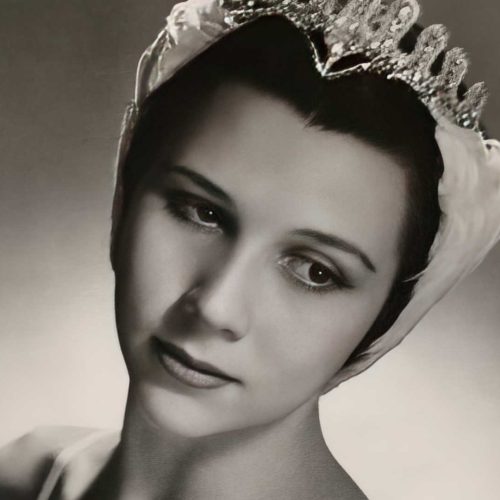Monica Ratcliffe
Monica Ratcliffe, one of British ballet’s earliest voices, shares a wonderful collection of memories and anecdotes with Patricia Linton. She talks about her years, in the 1920s, at Ninette de Valois’ Academy of Choregraphic Art in Roland Gardens, London, before the forming of the Vic-Wells Ballet, and recalls the very first performance of de Valois dancers at the Old Vic, as well as her encounters with Lilian Baylis, Lydia Lopokova, Olga Spessivtseva and many more. To introduce the episode, Voices of British Ballet founder, Patricia Linton talks to Natalie Steed about Monica and about her project: Voices of British Ballet.
First published: March 23, 2025
Biography
Monica was born in 1911 in Letchworth Garden City. The family were living in London at the start of the World War I, but moved to Berkhamsted, where Monica went to Berkhamsted High School with her sister. She picked up the rudiments of dance at school, but was inspired to train after watching Anna Pavlova dancing in a window at Selfridges. She joined Ninette de Valois’ Academy of Choreographic Art soon after it had opened. She loved her time with de Valois, especially when they were at the Old Vic. By 1932 her lack of enthusiasm for pointework had limited her performing repertoire, and she retired in 1933.
After World War II she became editor-in-chief for her second husband, Arnold Beck, Professor of Electrical Engineering and Fellow of Corpus Christi College, Cambridge.
Transcript
In conversation with Patricia Linton
Monica Ratcliffe: I was born on 29th July 1911.
Patricia Linton: And when did you decide to dance, decide to take it up seriously?
Monica Ratcliffe: Well I can tell you almost exactly, because [Anna] Pavlova came to England and Selfridges devoted an entire window to ballet with her doing the Dying Swan and I looked at this, and said to my parents I want to be allowed to dance, and then I went, I think with my sister and my mother, to see Pavlova.
And then, my brother fell in love with the girl who played the oboe in the Philharmonic Orchestra and she had a sister who was a very strange dancer. She was trained as a ballet dancer, but went off and did other things. Her name was Penelope Spencer, and she used to dance very curious, very modern duets with Hedley Briggs. And so I went to tea with her and said, ‘Where do I go?’ and she said, ‘There is someone called Ninette de Valois, who has started up a small studio in Roland Gardens, you might try her.’ And I went to two other places and they were simply awful.
And then I went to Ninette, who was in practice clothes and she just looked at me and said ‘You are the right build’, and so she said, ‘Well, come and sit in on the classes for a week and see what it looks like’, which I did. She worked strictly to [Enrico] Cecchetti – strictly, you know, Monday you did this and Tuesday this and so on, and then she gave me I think, two private lessons and she amused me by saying, ‘Are you sure? You’re too intelligent for this?’ and in fact when I wrote to her when she was either 90 or 100 she wrote a letter saying, ‘Of course I remember you, you used to get bad cramp in your feet and I always told you that you were too intelligent to dance.’ And I wrote back and said, ‘Thanks very much, I gave it up because I was not a good dancer.’
Patricia Linton: So before this, you had not done pliés and battement tendus?
Monica Ratcliffe: Not really; I knew vaguely the positions of the feet, but she simply, and Molly Lake too, simply took me through
Patricia Linton: Molly Lake was teaching there too at the same time?
Monica Ratcliffe: Molly Lake was teaching. She was marvellous, absolutely marvellous teacher, and Ursula Moreton was teaching, and she was not nearly as good a teacher. She wasn’t really focused on dancing the way the others were. She was a good dancer herself.
And then, Ninette got in touch with Lilian Baylis who wanted some girls to come and dance in the operas. And, we started off as a curtain raiser
Patricia Linton: Was this a ballet?
Monica Ratcliffe: Yes. It was a curtain-raiser ballet which was a series of Viennese Waltzes, it was called Homage to the Young Viennese I think, or Belles Viennoises.
Patricia Linton: Yes, Homage aux Belles Viennoises
Monica Ratcliffe: Yes. Right
Patricia Linton: This was created by Ninette [de Valois]?
Monica Ratcliffe: Yes, by Ninette herself.
Patricia Linton: Can you remember anything about how it looked, how it was dressed?
Monica Ratcliffe: Oh, I remember how we were dressed. It was a proper long tutu, I think we had little tiny sleeves, we might even have had tiny wings but I don’t remember and our hair absolutely flat and ringlets. It was a very bad performance
Patricia Linton: [laughs] In what way?
Monica Ratcliffe: Terribly amateur, I mean it was hopeless
Patricia Linton: Were there any men in it?
Monica Ratcliffe: No.
Patricia Linton: When you say it was amateur, you mean it was not rehearsed?
Monica Ratcliffe: Oh, it was rehearsed, but I mean we couldn’t any of us dance very well, it was sort of amateur dramatics you know, and then there was another ballet which we called either The Picnic or The Faun. I can’t remember how it finished up.
Patricia Linton: Can we go back to Roland Gardens and talk about a typical day there? How your day unfolded?
Monica Ratcliffe: Well, we didn’t start until fairly late, because we had probably been in a ballet the night before. We had an hour, hour and a quarter perfectly ordinary ballet class, and then one day we had character dancing, which was Spanish and Italian and Russian and so on. That came after it, and then in the afternoon we probably did rehearsals. We had a ghastly art class, which we all hated and thank goodness that stopped fairly soon.
Patricia Linton: Were you were actually painting or drawing?
Monica Ratcliffe: Yes. Hopeless. Oh, and we had barefoot dancing, which I always shone at, because I had done this in Germany, so that I was used to running barefoot, instead of prancing along in pointes. It was sort of not quite, Eurythmics, but not far off it.
Patricia Linton: Did Madam [Ninette de Valois] talk to you all?
Monica Ratcliffe: Oh yes. She was sweet. She had a very quick temper. She would quite suddenly just be furious with you and throw her stick on the ground. And I remember her saying to me once, ‘That’s right, pick it up.’ I was never frightened of her, I think that one or two of them were. She used to come and have dinner with us occasionally and my father ticked her off for calling herself Ninette de Valois and asked her what her real name was, which, of course, was Edris Stannus, and my mother just called her ‘Ninette Dear’ and that was that. And then, when my feet got bad and I was in less and less things, she used to chuck beginners at me, because she would frighten them.
Patricia Linton: So these were new girls who had applied to the school?
Monica Ratcliffe: Yes and she would say to a beginner, ‘Oh for God’s sake, get Monica to show you’ and then I would, and gradually I took over very much of the beginners’ classes, and then I used to take over rehearsals and things.
Patricia Linton: So she had a lot of faith in you in fact?
Monica Ratcliffe: Well, she knew that I could teach people who were nervous. And I have always thought that it is partly because I am very small and the beginners were about my size, and they weren’t scared of me. I can’t remember when, it was at some point after we did these odd things at The Vic, and then Ninette told us that we were actually moving to The Wells and that we were The Vic-Wells Ballet.
Patricia Linton: So that was about 1931? Had you already started these performances at The Festival Theatre here in Cambridge, here at this point, could you talk a little bit about those and how they came about?
Monica Ratcliffe: Well, they came about because Ninette was a cousin of Terence Gray. As far as I remember, I think we only did the two Greek plays. We did them for a week in May Week, which was absolutely wonderful. I cannot tell you what we wore for the tragedy, I can only remember a marvellous dark green and silver mask with a half-face with a straight nose, which was very attractive.
Patricia Linton: This was for Antigone?
Monica Ratcliffe: That was Antigone. And the other one was these ridiculous togas. And every character had the boots and the hat of the right things. So the soldier had a real cheese cutting soldier’s hat and soldier’s boots up to here. Everybody was masked. The girls had a mask, and the curious thing is if you dance in a mask, you use your body in quite a different way, because you can’t use your face.
Patricia Linton: And did you stay in Cambridge?
Monica Ratcliffe: Yes, we stayed in digs.
Patricia Linton: Do you remember those?
Monica Ratcliffe: Yes, they were awful. There was an outside loo. I went in with Freda [Bamford], we had an enormous double bed with a feather bed thing on the top.
Patricia Linton: And did you all get on well, your original group?
Monica Ratcliffe: Oh yes. Fine. Beatrice [Appleyard] and Joy Newton were the two tall ones and Freda Bamford and Sheila [McCarthy] were the two middle ones and Nadina [Newhouse] and I were the two small ones. We all got on very well. I was particularly fond of Joy [Newton] and of Freda, I knew them both very well. Sheila was a bit of an outsider, she just came to classes and disappeared again.
Ninette said when we started, ‘We’ve got to make a success of this and I am relying on you.’ She was right, I mean, we would do anything, any sort of ballet, any sort of costume, any sort of rehearsal times, anything.
Patricia Linton: Did you have this sense that you were creating something special?
Monica Ratcliffe: I don’t think so. It was extremely interesting.
Patricia Linton: Were you aware of Lilian Baylis being there, did she talk to you?
Monica Ratcliffe: Oh yes! Oh Lord, yes. She was very large and very stout and the sort of person who seems to wear about 10 different scarves. You know, frightful mess, and she had this ghastly little dog, I can’t think what sort it was, but it was a horrible, smelly, snuffly thing, and she’d walk around all the corridors and would refer to us as ‘My darling boys and girls’ you know; she would meet you and go, ‘Well my darling, I haven’t seen you.’ She was lovely. She was terrific fun; when we were at The Vic, she was just around all the time, and she would be sitting in the box watching rehearsals and things and shows. She didn’t come to The Wells very much, as I remember.
I suppose one of the most marvellous memories is [Lydia] Lopokova, who danced with us for a year and was absolutely marvellous. I mean, we all adored her. She was extremely funny. When she got paid at the end she refused to take it, and it was divided up between us, which we thought was absolutely angelic because we were paid nothing.
And for some time we had Olga Spessiva [Spessivtseva], she called herself because it was easier for the printers.
Patricia Linton: Do you remember her dancing?
Monica Ratcliffe: I remember her dancing and I remember that she danced Sylphides. We didn’t speak to her at all, I mean she arrived and vanished again.
Patricia Linton: Was there anything particular in their dancing that you remember that stands out to you?
Monica Ratcliffe: I think the absolute tops was when she did the Tango with Freddie Ashton
Patricia Linton: This is Lopokova?
Monica Ratcliffe: Which was unbelievable, she looked like nothing on earth, she had the most ludicrous costume and Freddie was marvellous, of course, and they were marvellous together. That was in Façade. And I always remember very, very well Alicia Markova in Façade.
Patricia Linton: In the Polka?
Monica Ratcliffe: Yes, and there was this door, you know, like a tradesman’s door.
Patricia Linton: A stable door?
Monica Ratcliffe: Yes. And it was open at the top and she was sort of looking out and looking very sweet and very pretty, and she suddenly opened the bottom half and walked out in a little skirt about that high, which she took off and she was in little brief knickers, and of course the audience nearly died of shock, but she had these wonderful legs and feet, you know, absolutely gorgeous. I liked her very much. She had a crispness about her that nobody else ever had that I saw.
Patricia Linton: Did she mix with you?
Monica Ratcliffe: Fairly is the answer. She got on very well with all the boys.
Patricia Linton: We haven’t really talked about the boys, the boys that were around.
Monica Ratcliffe: Oh, they were wonderful. We started off with Stanley Judson, who was the nicest possible person; he was just absolutely sweet and I remember I was down in the wings one day and he came down and said, ‘Oh Monica I am terrified, do go through the Grand Valse with me,’ because he was doing it with, I suppose it must have been Spessiva, you know (sings tune)
Patricia Linton: From Sylphides?
Monica Ratcliffe: I went through it with him just so that he was quite sure he had got it, he was lovely, completely unaffected and most charming to all of us. We all loved him and then we imported the other ones, Freddie Ashton who was great fun and Billy [William] Chappell who was immense fun and a wonderful dancer.
Patricia Linton: Walter Gore, was he there?
Monica Ratcliffe: Walter Gore. He was very nice, he was a bit more reserved than the others and Hedley Briggs was with us for some time, and he must have come to us pretty early I think, and then, of course, we had Anton Dolin.
I gave up dancing in 1933, and I went to Ninette and said I am never going to be any good, and I don’t particularly want to be teaching, I’m not interested in that. And I very seldom went to the ballet. I found I didn’t like it any more. I went once or twice and I found that I really didn’t particularly like it and so I didn’t go any more.
The transcript of this podcast may have been lightly edited for ease of reading.





